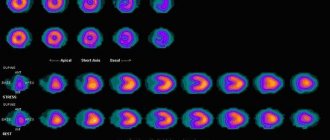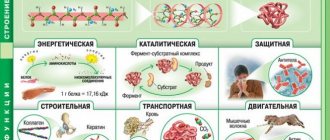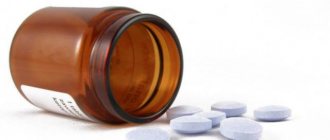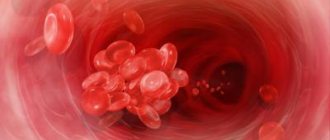Eosinophilic cationic protein (ECP) is one of the laboratory signs (markers) of allergies. Its increase in the blood indicates an exacerbation of bronchial asthma, diseases of allergic origin - runny nose, dermatitis (skin inflammation), food intolerance. It is prescribed to diagnose such diseases and determine the degree of their severity and the results of therapy.
The test is carried out using venous blood; a concentration of up to 24 ng/ml is considered normal. A decrease in indicators is a sign of treatment success and the cessation of allergen intake. This test is more accurate than the standard determination of eosinophils or immunoglobulin E, since it shows the allergic reaction first. Blood tests are also used for expert assessment of exacerbation of bronchial asthma (for example, among conscripts).
What is cationic protein, its norm and importance for the body
Eosinophil cationic protein may be elevated in the presence of relevant diseases. In the medical documentation it is indicated under the ESR code. This is a basic marker of eosinophils. It is a biochemical enzyme that in its composition and functions resembles the ribonuclease of a digestive organ such as the pancreas.
Released into the blood serum as a result of contact of a potential allergen with immunoglobulin molecules. In addition, eosinophilic protein takes an active part in neutralizing irritants that enter the body of a particular person along with food, drink, air or during contact with the skin surface.
ECP is able to stimulate the activity of lymphocytes, which provides a more powerful and extensive immune response aimed at suppressing the pathogenic activity of allergens.
That is why a protein compound of this type is considered by doctors as a physiological identifier that allows them to track the dynamics of the progression of an allergic disease, determine the improvement in the patient’s well-being, or the worsening of current symptoms.
In the process of treating allergies of all types, donating blood for eosinophilic cationic protein is a prerequisite.
If immunoglobulin E and eosinophils are elevated
An increase in ECP and immunoglobulin E, eosinophils are signs of the presence of allergic diseases. At the same time, the analysis for cationic protein is considered the most sensitive test; it reacts to the presence of an allergen even in cases where other indicators are normal.
The protein concentration accurately reflects the severity of the disease; it increases simultaneously with the main symptoms (itching, rashes, asthma attacks, digestive disorders). When the condition improves due to treatment or removal of the provoking factor, the analysis shows a decrease in ESR.
Norm of cationic protein indicator
The concentration of the protein compound is proportional to the number of eosinophils in the blood. Below is detailed information about the ESR standards for healthy people, as well as those with various types of diseases.
| Normal indicators | Health status |
| 7 µg/l | Typically for a person who has no signs of an allergic reaction. There is no acute immune response to an external or internal irritant of lymphocytes. |
| 15 to 20 µg/l | Similar indicators are found in patients suffering from bronchial asthma of an allergic nature, which periodically goes into an exacerbation stage, which is expressed by attacks of suffocation. |
| 60 to 70 µg/l | Diagnosed in patients infected with invasive species of helminth infections (for example, from the Schistosoma family), when the venous blood is oversaturated with parasitic life forms. |
| About 200 µg/l | It is typical for patients with hypereosinophilic syndrome, which is extremely rare. |
Determining the concentration of ECP is an important step in the diagnosis of diseases of allergic origin. Establishing the norm of eosinophilic protein is used in the field of pulmonology, parasitology, dermatology, as well as in the presence of autoimmune diseases.
Normal values
The norm for this indicator in an adult is 7 ng/ml. Eosinophils in a child under 12 years of age are normally 0.5-7 ng/ml. Acceptable index values for adults and children are from 0 to 24 ng/ml.
If the indicator is more than 15 ng/ml, the result is considered elevated, and it indicates an allergic reaction. A decrease in the index has no basis for diagnosing any pathology. The analysis result will be ready in 2-4 days.
Reasons for increased cationic protein levels
Eosinophilic cationic protein is elevated in the presence of pathological processes in the human body.
Most often, a surge in ESR occurs in people with concomitant diseases, namely:
- rhinitis of an allergic nature, which occurs as a result of contact of the nasal mucosa with a potential irritant (may differ in seasonal manifestations or be permanent);
- extensive insemination of the body with eggs and larvae of helminths;
- gastroenteritis in the acute stage, esophagitis of the eosinophilic type, colitis;
- bronchial asthma, which developed as a complication of an existing allergy;
- intolerance to certain types of food (milk, strawberries, citrus fruits, cereals containing gluten);
Reasons for increased eosinophil cationic protein - acute inflammatory process that has developed in the larynx, provoked by a bacterial or viral infection;
- living in rooms with high levels of humidity, where mold fungi and their spores are common;
- the presence of benign and malignant neoplasms in the paranasal sinuses (polyps, carcinomas);
- hypereosinophilic syndrome;
- atopic dermatitis;
- long-term therapy with drugs containing minocycline, penicillin, phenobarbital, co-trimoxazole.
An increase in ECP levels can be caused by long-term use of non-steroidal anti-inflammatory drugs. In the event of a sharp surge in the concentration of eosinophilic cationic protein, it is necessary to stop taking medications and also undergo examination for the presence of the above diseases.
What does it show
ECP is one of the mediators of eosinophils; it releases them from granules in response to the entry of an allergen into the body and the release of immunoglobulin. This is an enzyme that destroys RNA, and in its structure and actions is most similar to pancreatic RNA.
ECP is toxic to mast cells, epithelial cells, smooth muscle cells, and fibroblasts. It has an immunomodulatory effect because it stimulates the immune response by affecting lymphocytes.
Eosinophils are present in the mucous membranes of almost every hollow organ, most parenchymal ones, and therefore the release of ECP has different clinical symptoms. Protein plays an important role in diseases of an allergic nature - asthma, rhinitis, dermatitis, food allergies. Its content in plasma increases greatly against the background of an allergic response when an allergen enters the body. Protein is a marker of exacerbation of hypersensitivity; it is used to assess the intensity of exacerbation and monitor treatment.
Protein level test
Symptoms of increased cationic protein levels
Eosinophilic cationic protein is elevated only in those clinical cases where concomitant signs of the underlying disease are already present.
A person whose serum concentration of ECP is too high experiences the following symptoms:
- the skin surface is constantly itchy, characterized by increased dryness, redness, sensitivity to sunlight, contact with synthetic clothing, and a tendency to develop dermatitis;
- allergic rhinitis, prolonged sneezing, persistent nasal congestion, headache (all these symptoms intensify after interaction with a potential allergen);
- sudden attacks of suffocation, expressed in bronchial spasm or swelling of the laryngeal mucosa;
- ulcerative formations in the oral cavity, when the bacterial microflora is within normal limits, and wounds on the mucous membrane occur as a consequence of an allergic reaction;
- a disorder of the digestive system that occurs immediately after eating certain types of food (bloating, nausea, vomiting, rumbling begins, the stomach stops, intestinal motility decreases, diarrhea begins, there is pain in the center of the abdominal cavity);
- disturbance of the rhythmic activity of the heart, dizziness, shortness of breath, decrease or sudden increase in blood pressure (most often, patients are diagnosed with stable hypotension).
Depending on what exactly provoked the increase in ESR, the above symptoms are intense to a greater or lesser extent. Due to the vague clinical picture, an increase in eosinophil cationic protein may be confused with other diseases.
Indications for research
The most common indication for a primary blood test for ECP is making a diagnosis and distinguishing allergic inflammation from all others. The release of protein in increased quantities also has clinical manifestations, since normally 99% of eosinophils are found in tissues and only 1% of the total quantity circulates in the vessels.
The doctor prescribes a test if you suspect:
- allergic rhinitis: sneezing, itching in the nasal cavity, nasal congestion, deterioration of breathing, odor intolerance, the coincidence of these symptoms with the time of flowering of plants (seasonal rhinitis);
- obstructive bronchitis, bronchial asthma: cough, difficulty breathing, asthma attacks, especially if symptoms increase after contact with animals, being in nature, or inhaling house dust;
- food intolerance: abdominal pain, diarrhea, rumbling, nausea, vomiting, redness of the face, swelling of the mucous membranes of the pharynx, sore throat, small blistering itchy rash on the skin, dizziness after eating milk, eggs, fish, nuts, wheat flour;
- atopic dermatitis: redness and itching of the skin, dryness and thinning of the upper layer, rash, peeling, which periodically intensify or subside; for children under 2 years of age, a typical connection with nutrition.
Atopic dermatitis in children
After diagnosis, analysis is needed to determine the severity of the exacerbation and the intensity of inflammation. It is used to determine the dose of drugs, the need to administer hormones and the time when dosages can be reduced or drugs discontinued.
Diagnosis of cationic protein levels
Eosinophilic cationic protein is elevated or within normal limits, which can only be determined by a comprehensive examination of the whole organism. The reason for the violation of the ESR norm is also established. After the patient arrives for an appointment with a doctor, his initial examination is performed, complaints are listened to, and current symptoms are established.
After this, the person must undergo the following types of tests:
- checking stool for the presence of helminth eggs and larvae;
- general examination of capillary blood;
- removal of the leukocyte formula;
- collection of sputum secreted during coughing, with further laboratory analysis of microflora;
- examination of venous blood for helminthiasis;
- general urine analysis;
- screening isolation of immunoglobulins that are active against such potential allergens as epithelial fibers of cats, rabbits, dogs, dust mites, birch pollen, alder pollen, poplar fluff, wool, mold spores.
If, based on the results of an examination of venous blood or feces, traces of the presence of parasites are found in the patient, he is advised to undergo an ultrasound examination of the abdominal organs. The last type of instrumental diagnostics is necessary to determine the localization of helminths in order to quickly and effectively remove them in the future.
Preparing for the test
ECB referral is given by specialists hematologists, allergists, dermatologists, and immunologists. The test result, especially in older adults, may be required by a rheumatologist to exclude or confirm an autoimmune disease.
An eosinophil protein test is performed on an empty stomach in the morning. No food is taken for 8 hours before the test.
Do not smoke 3 hours before taking the test. You can only drink clean non-carbonated water. 30 minutes before the test, eliminate physical and emotional stress.
On the eve of the test it is prohibited:
- consumption of alcoholic beverages;
- eat fatty foods;
- take medications and dietary supplements.
Women do not take ECP during menstruation because eosinophils are elevated during this period. In addition, the result can be improved if performed immediately after a fluorographic examination, ultrasound, or physical therapy.
It is allowed to donate blood for ECB during the day after a small meal at least 4 hours before the test.
The level of ECP in the blood reflects the severity of the allergy condition. Using the test, you can monitor the progress of treatment and recovery for bronchial asthma, atopic dermatitis, and autoimmune disorders.
The magnitude of the deviation from the norm gives an idea of the type of immune disorder that caused an increase in the level of cationic protein.
Analysis in adults
The most significant increase in the content of cationic eosinophilic protein is found in myeloproliferative, i.e., caused by uncontrolled division of stem cells, blood cancer. The result of the analysis exceeds 100 – 200 ng/ml for these diseases.
The results of testing for eosinophilic protein in adults with breast cancer and epithelial ovarian cancer have been increased. The same high ECP values are found in eosinophilic inflammation, which is provoked by the accumulation of eosinophils in target organs.
Infection with parasitic worms causes an increase in test values in both adults and children to 60 - 70 ng/ml. Bronchial asthma increases the test results to 15 - 20 ng/ml; allergic reactions are characterized by indicators of 15 ng/ml.
Cationic eosinophil protein is increased in adults with Churg-Strauss syndrome. The disease is manifested by an inflammatory reaction of allergic origin involving blood vessels.
Adults from 17 to 70 years old are affected. The age of those affected is predominantly 40–50 years, and women suffer from Churg-Strauss syndrome more often than men.
ECP test in children
The most common causes of elevated eosinophil protein in children are allergic reactions and helminth infection. High test values for ECP, comparable to values for helminthiasis, are observed in a child with atopic dermatitis.
In addition to allergies and helminthiases, an increase in ECP can be caused by:
- scarlet fever;
- chicken pox;
- acute respiratory infections, influenza;
- severe bacterial respiratory or intestinal infection.
A child may have increased levels of cationic protein eosinophils with sinusitis and otitis media. The cause of the increase may be ARVI caused by respiratory syncytial virus.
In the smallest children - newborns, an increase in ECP occurs:
- as a result of Rh conflict;
- when infected with staphylococcal infection;
- for dermatitis.
Eosinophil cationic protein testing is not used as a primary diagnostic test. The final diagnosis is established using not only data on the content of cationic protein, but also the level of IgE, leukocyte formula, C-reactive protein and other tests.
A marker of an allergic reaction, in addition to analysis for cationic protein, is a test for the level of immunoglobulin IgE. The content of this protein increases sharply during an IgE-mediated allergic reaction.
If ECP is elevated in the blood, but IgE is normal, this indicates that the inflammation is caused by an IgE-independent process.
Similar study results indicate the possibility of bacterial inflammation of the paranasal sinuses (sinusitis, ethmoiditis), nasal sinus polyposis, kidney tumor, respiratory syncytial infection, DRESS syndrome.
Cationic eosinophilic protein is increased, but IgE is normal, with IgE-independent food allergy, IgE-non-mediated atopic reaction. Atopic reactions include local manifestations of allergies, which do not require the presence of an allergen in the blood to trigger. The atopic type can cause dermatitis, urticaria, conjunctivitis, and bronchial asthma.
Prevention of elevated cationic protein levels
Eosinophil cationic protein is elevated in people who do not take preventive measures aimed at preventing the development of diseases that increase the concentration of the enzyme.
In order for the ECP level to be within normal limits, the following rules must be observed:
- Before eating, wash your hands thoroughly with warm water and soap;
- do not eat dirty fruits and vegetables;
- avoid swimming in bodies of water with dirty or drainage water;
- promptly treat bacterial and viral diseases of the nasopharynx;
- prevent polyposis of the nasal sinuses, and if foreign tumors appear, take measures to remove them;
- do not eat foods that are not accepted by the digestive system and cause an allergic reaction;
- do not transform inflammatory lung diseases, bronchitis into a chronic form;
- carry out wet cleaning regularly in the rooms of a house or apartment so that there is no accumulation of dust;
- If you are allergic to wool, then you must avoid prolonged contact with pets and fluff.
In the summer and spring, when the concentration of allergens in the form of pollen and poplar fluff in the air increases, you should regularly take antihistamines. The prescription of the medication, dosage and duration of therapy are determined by the doctor. Unauthorized treatment can worsen your health.
When is ECB prescribed?
A blood test for cationic eosinophil protein is prescribed if the patient has the following symptoms:
- difficulty breathing or attacks of suffocation upon contact with animal hair, plant pollen, dust;
- skin rashes accompanied by itching;
- runny nose or sneezing when in contact with allergens;
- skin rashes, swelling of the nasopharynx, sneezing and dyspepsia after eating certain types of food.
However, blood testing for ECP alone is not sufficient to make an accurate diagnosis. Additional tests are usually required.
A few days before the scheduled test, you should avoid taking medications that could affect the test results. Such drugs include:
- antibiotics;
- tranquilizers;
- interferon medications;
- laxatives containing psyllium;
- central nervous system stimulants.
It is also not recommended to eat fatty foods or drink alcohol a few days before the analysis. Before the study, you should not smoke, do heavy physical work, drink sweet tea, coffee, or juices.
The test is taken in the morning on an empty stomach. You should stop eating 8-12 hours before the test. You can only drink clean water.
Which doctor should I contact?
An elevated ECP level is not always a sign of an acute allergic reaction. To establish the true cause of the high concentration of eosinophilic cationic protein in the blood serum, it is necessary to use the data of an instrumental examination and the conclusions of laboratory tests of blood, feces, and urine.
To do this, the patient can contact such specialists as an allergist, therapist, dermatologist, pulmonologist. A pediatrician treats children. Initially, it is recommended to visit a specialized specialist, taking into account the present symptoms.
ECB analysis - methodology and preparation
To prepare, you need to follow these rules:
- limit the consumption of fatty foods per day, also give up alcohol and intense physical activity;
- Before the test, ultrasound, fluorography, radiography, and any physiotherapeutic procedures are not performed;
- It is not recommended to eat 14 hours before, but drink only clean water;
- When taking any medications, you should discuss the rules for stopping them and the time of withdrawal with your doctor.
Half an hour before donating blood, you should try not to tense up or be nervous.
Blood for research is taken from a vein.
Treatments for elevated cationic protein levels
Reducing the elevated level of ECP is possible only in the case of successful treatment of the underlying disease that caused an acute immune reaction of the body.
During the treatment process, conservative therapy can be used, including the use of pharmaceutical medications, folk remedies, as well as an immunization method if the patient is prone to allergies. The following are the most effective ways to reduce eosinophil cationic protein levels.
Drug therapy
The use of medications is necessary to treat a disease that causes the release of ECP into the blood. The type of medications used directly depends on the diagnosed disease.
In the process of reducing eosinophilic cationic protein, the following drug therapy can be used:
- Aleron - taken to relieve an allergic reaction (recommended dosage is 1 tablet per day, taken at the same time, and the course of treatment is no more than 1 month);
- Suprastin - take 2-3 tablets a day until the allergy symptoms completely disappear, and therefore the ECP level decreases (the maximum daily dose is 4 tablets, and the average duration of taking the drug is 2-3 weeks);
- L-Cet - you need to take 1 tablet a day at the same time without chewing (the course of therapy is 1-2 weeks, it is prescribed with caution to people with impaired renal function);
- Vermox is a drug that allows you to reduce eosinophilic protein, which is increased as a result of helminth infestation (take 1 tablet in the morning and evening for 3 days, and after 2 weeks the course of therapy is repeated);
- Pyrantel - the course of treatment consists of a single dose, which is calculated as follows: a child over 6 years old takes 1 tablet per 20 kg of weight, an adult weighing less than 75 kg - 3 tablets, over the specified weight - 4 tablets (after 2 weeks the treatment procedure is repeated).
In most cases, the cause of increased ECP is an acute allergic reaction or helminth infestation, so the above drugs are used to reduce the concentration of eosinophilic cationic protein.
If a violation of the ESR norm is provoked by an inflammatory process in the nasopharynx, then the attending physician determines the strain of the infectious pathogen and selects medications, the main components of which can suppress the activity of bacterial or viral microorganisms of a particular type.
Traditional methods
In addition to pharmaceutical medicines that help stabilize the level of eosinophilic cationic protein, there are folk recipes that have similar properties, namely:
- take 1 tsp. dried wormwood, pour into a thermos, and then pour 0.5 liters of boiling water and close the container, leaving to infuse for 1.5 hours (take 2 tsp 3 times a day 30 minutes before meals, course of therapy - 10 days);
- collect 3 tbsp. l. partitions of walnuts, pour 500 ml of vodka or moonshine over them, put them in a dark and cool place for 7 days, and then take 50 ml 2 times a day before meals (course of treatment is 7-10 days);
- take 1 tsp. dried tansy leaves, crushed gentian and chamomile roots, pour medicinal plants into a metal container, pour 1 liter of running water, and then boil over low heat for 15 minutes. (take the resulting decoction 100 ml 3 times a day 20 minutes before meals, and the duration of treatment is from 10 to 14 days);
- you will need to take 1 tbsp. l. flax seeds, grind them in a coffee grinder to a powder, pour into a thermos or any other container that retains heat well, and then pour 0.5 liters of boiling water (take 150 ml 3 times a day 30 minutes before meals for 7 days);
- collect 300 g of dehulled pumpkin seeds, grind them to a pulp using a meat grinder, add 150 ml of cold boiled water and take the resulting mixture 3 times a day, 1 tbsp. l. in 15 minutes before meals for 15 days.
Before starting self-treatment for elevated ECP levels, it is necessary to undergo a comprehensive examination of the body, determine the cause of the disease and consult with a specialized doctor. This will avoid possible complications and deterioration of well-being.
Surgery
Another method of therapy aimed at stabilizing the level of eosinophilic cationic protein is surgery aimed at removing benign or malignant tumors growing in the paranasal sinuses.
It is used if, based on the results of the examination, the exact cause of the increased ESR was established. The operation is performed under local or general anesthesia. Lasts no more than 30-40 minutes. The rehabilitation period is 5-8 days
Vaccination
An alternative treatment is to immunize the patient. To prevent the occurrence of an acute allergic reaction, a person prone to an immune response to potential allergens is vaccinated in advance.
This is a standard vaccination procedure in which small doses of a specific type of irritant are introduced into the body, antibodies are gradually produced in the blood serum, and the immune system no longer reacts with an extensive inflammatory process with the release of large amounts of eosinophilic cationic protein.
How is the analysis done?
To conduct a test for cationic eosinophil protein, blood is taken from a vein. Then the test tube with the material is sent to the laboratory. The blood is centrifuged to separate the red blood cells. The serum is studied using the immunochemiluminescent method.
This research method is based on the reaction of an antibody with an antigen. The protein contains arginine, an amino acid that is detected using monoclonal antibodies.
This is an informative research method that gives reliable results in 90% of cases. In diagnostic laboratories, the analysis is done quite quickly, usually the results are known within 1-2 days.
Complications
The presence of an increased level of ESR is fraught with disruptions in the functioning of internal organs, as well as the body’s life support systems. The following possible complications and negative consequences that can be caused by a high concentration of eosinophilic cationic protein are identified:
- digestive disorders, poor absorption of vitamins, minerals and other nutrients supplied with food;
- worsening of the allergic reaction, when it begins with rhinitis and turns into bronchial asthma with frequent spasms of the respiratory tract;
- deterioration of the health of the skin and hair, the appearance of excessive dryness of the epithelium, the formation of wounds and cracks;
- bowel disorder, expressed in frequent constipation or diarrhea;
- inability to lead a full social life, since an extensive immune response stimulated by an increased level of ECP will cause rhinitis, cough, and the body’s inability to accept certain types of foods that are potential allergens (milk, eggs, cottage cheese, citrus fruits, fish, nuts, honey).
The most dangerous complication of elevated eosinophilic cationic protein is fulminant swelling of the laryngeal mucosa, as a result of which the patient is unable to breathe normally.
A similar reaction of the body is possible if the patient did not treat the allergy, did not take measures to reduce the level of ECP, which resulted in anaphylactic shock and death.
Article design: Vladimir the Great
Diagnostic reliability
The analysis helps determine the severity of inflammation or allergies. The study is especially important for atopic dermatitis, bronchial asthma, and some autoimmune diseases.
If the study showed an increase in the level, then for an adult this result means the following:
- rapid and uncontrolled cell division in the body;
- increased likelihood of blood cancer - with an extreme value of 100-200 units;
- development of the inflammatory process of internal organs.
Infection with parasites is usually indicated by indicators of 60-70 units, a tendency to hypersensitivity - over 15 units, and bronchial asthma - 15-20 units.
When the cationic protein in eosinophils in a child’s body is increased, helminthiasis or allergies are usually diagnosed, less often the disorder is provoked by the following diseases:
- sinusitis;
- otitis;
- scarlet fever;
- chickenpox;
- intestinal infections.
A cold also leads to exceeding the normal limit.
Treatment
To prescribe treatment, you need to find out the cause of the increased eosinophil count.
In this case, a number of additional examinations are required, including:
- stool and urine analysis;
- X-rays of light;
- allergy diagnosis;
- kidney and liver tests;
- serological tests for the presence of connective tissue diseases and parasitic infections.
After diagnosis, treatment is prescribed for the underlying disease, which caused an increase in the number of eosinophils in the blood. For allergies, the influence of the allergen is eliminated. In such a dangerous condition as hypereosinophilic syndrome, drugs are prescribed that reduce their production, otherwise this pathology can cause damage to vital organs. Reasons for the increase in children
There are three forms of eosinophilia in children:
- reactive,
- primary
- family.
The reactive form is most common. In this case, eosinophils in the blood reach moderate values. It develops as a result of intrauterine infections, allergies to cow's milk and medications, fungal diseases, helminthic infestations, malignant tumors, skin pathologies, etc.
Primary eosinophilia is a very rare form. This severe pathology leads to damage to the lungs, heart, and brain as a result of compaction of their tissues with a large accumulation of eosinophils in them.
In the familial form, pronounced chronic eosinophilia is observed. It usually occurs at an early age and manifests itself as asthmatic bronchitis.











